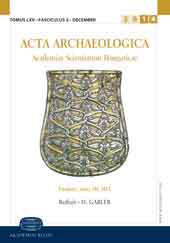Szeletian felsitic porphyry: non-destructive analysis of a classical palaeolithic raw material
Szeletian felsitic porphyry: non-destructive analysis of a classical palaeolithic raw material
Author(s): András Markó, Katalin T. Biró, Zsolt KasztovszkySubject(s): Archaeology, Ancient World
Published by: Akadémiai Kiadó
Keywords: Szeletian felsitic porphyry; raw material; Paleolithic; Hungary;
Summary/Abstract: Szeletian felsitic porphyry is one of the most famous raw materials used in the Hungarian Palaeolithic. It was identified, under various names, by students of the Palaeolithic material of the Bükk region in the earliest petroarchaeological descriptions. Due to its high silica content and homogeneity it was erroneously identified as hornstone, later as ash-grey chalcedony, even in petrographical descriptions based on thin sections. Interestingly, the geological source was placed on the plateau of the Avas, where solid ‘flint’ and ‘chert’ were reported. With the advance of new analytical methods and their application to archaeology, Lajos Tóth, at that time general engineer of the Diósgyôr Steel Works, and László Vértes, curator of the Hungarian National Museum, performed a classical study to fingerprint this material.
Journal: Acta Archaeologica Academiae Scientiarum Hungaricae
- Issue Year: 54/2003
- Issue No: 3-4
- Page Range: 297-316
- Page Count: 20
- Language: English
- Content File-PDF

